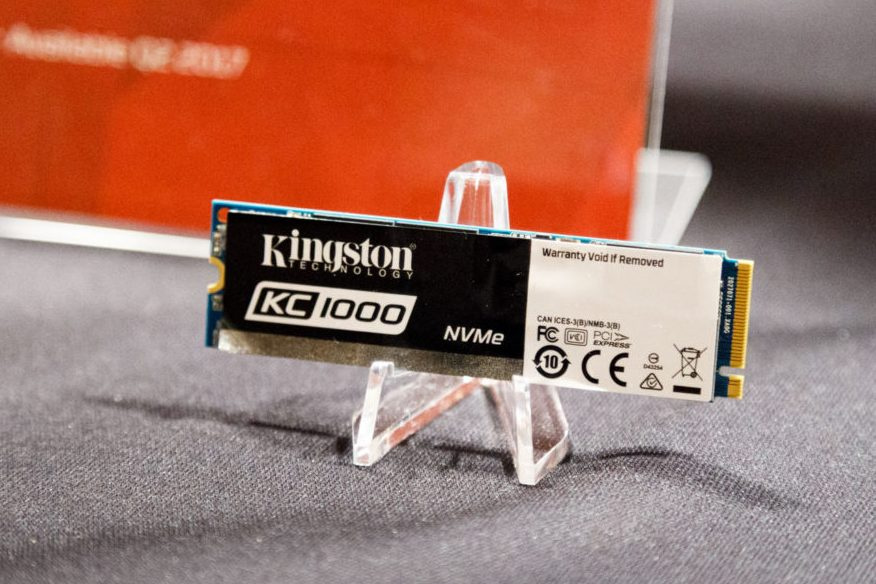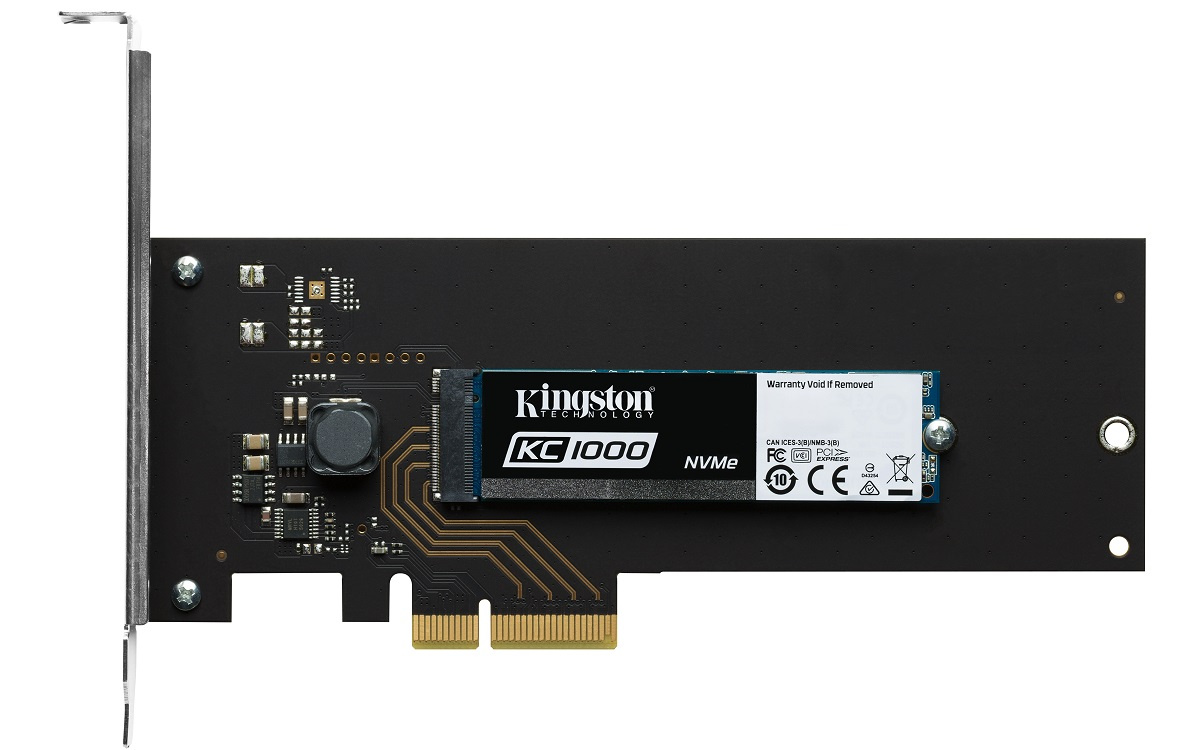Ladies and gentlemen, we would like to inform you that Kingston is “on the edge of attack”: the fastest SSD of the company was released at Computex 2017, and the first model under the control of NVMe protocol. We tell you what KC1000 is made of, what is special about it, and what speed with reliability you can expect from one of the best drives of the 2017 model year.

God save the competition! Thanks to it, in 2017, the progress in desktop processors has finally shifted from the dead point, and from its very own, SSD turned from “toys for rich” iron lovers to truly “popular” drives. And they didn’t stop the development, but took a step further - to the high-speed lines of the PCI Express 3.0 bus.
At the same time, the transition from SATA-III to the new interface took place in just a couple of years: in 2014, such drives demonstrated as a “bright future”, and in 2015 it was fashionable to sentence “yes to me and with the outdated format well!”. And in 2017, not only the form factor M.2 became customary, but even the transition from the AHCI protocol to NVMe ceased to be a geek's fun. We will talk about what these terms mean a bit later, and now - the highlight of the program.
"Very nice, king!"
So, KC1000 is the new flagship of Kingston. Typically, models with maximum speed go out from the pen of HyperX, but our hero is sharpened not under the record download speed of game levels, but under the maximum loads that can occur on SSD in workstations or servers. However, with such a margin of performance, the drive will be fast "under any sauce." Judge for yourself:
Speed in sequential operations: 2.7 GB / s in read mode and up to 1.6 GB / s (depending on the capacity of the drive) in write mode. This is not only one of the highest results among serial SSDs of all times, but also a “bell” that the allegedly excessive speed limits of interfaces for solid-state drives are not that redundant.
Because the maximum bandwidth of the interface PCI Express 3.0 x4 in reality is up to 3.2 GB / s. That is, in the read mode, the flagship drives are already close to the “ceiling” of performance, and are moving towards this in successive write operations.

And this speed of work of the KC1000 does not at all in “sterile” conditions, when one file is copied, and everyone around does not breathe and does not move the cursor just in case - the factory figures are revealed in the mode of much more intensive multi-threaded load.
Performance in arbitrary operations: up to 290000 IOPS. This is the level of the most elite SSD of our time, achievable thanks to the correctly selected controller and memory. By the way:
Controller: Phison PS5007-E7. On the creation of this controller, you can write a book. In short, the newest quad-core eight-channel model, which Phison designed for two years. Supports NVMe 1.1b protocol and new NAND types. For a long time, Phison limited themselves to inexpensive models, but for a couple of years they were engaged in the creation of a flagship controller, and, I must say, for good reason.
When it comes to flagship SSDs, enthusiasts expect to see Marvell controllers - because Marvell de is “hardcore customization” for each individual drive manufacturer. So it is, and HyperX proved the strength of such a decision in the flagship Predator. But in the same quality lies the trick - the new Marvell Eldora with NVMe support requires a serious amount of work to bring them to a really high level of performance with new types of memory. Phison in this regard so far looks preferable.
Protocol: NVMe. Not just “to be”, but because the previous AHCI was developed under hard drives, and took into account all the “bugfits” of mechanical drives, which, to put it mildly, are not relevant to the SSD. NVM Express was developed taking into account drives based on flash memory and initially took into account the ability of SSD to multi-stream data processing (tens of thousands of simultaneous requests) and without regard to the limitations characteristic of HDD.
 What are the pitfalls of NVMe?
What are the pitfalls of NVMe? Problems with the support of a number of operating systems. True, drives based on Phison E7 - a pleasant exception. With the help of the universal stornvme driver, you can add drive support even to Windows 7, which has problems with working with modern NVMe drives out of the box.
Reliability: five years warranty with a declared average time between failures (MTBF) of 2 million hours and a guaranteed recording capacity of 300 to 1000 TB, depending on the initial capacity of the drive.
TLDR, read the entire list, please!
Announcing:
•
Form Factor: M.2 2280
•
Interface: NVMe PCIe Gen 3.0 x4
•
Capacity: 240, 480, 960 GB
•
Controller: Phison PS5007-E7
•
NAND memory: MLC
• With
sequential read / write speed:240 GB: up to 2700/900 MB / s
480, 960 GB: up to 2700/1600 MB / s
•
Maximum read / write speed of random blocks 4 KB240 GB: up to 225 000/190 000 IOPS
480, 960 GB: up to 290 000/190 000 IOPS
•
Read / write speed of random 4 KB blocks:240, 480 GB: up to 190 000/160 000 IOPS
960 GB: up to 190 000/165 000 IOPS
•
PCMARK Vantage HDD Suite rating: 150,000
•
Total number of bytes written (TBW):240 GB: 300 TB and 0.70 DWPD
480 GB: 550 TB and 0.64 DWPD
960 GB: 1 PB and 0.58 DWPD
•
Power consumption: 0.11 W (idle) / 0.99 W (average) / 4.95 W (maximum when reading) / 7.40 W (maximum when writing)
•
Storage temperature: -40 ° C to 85 ° C
•
Operating temperature: 0 ° C to 70 ° C
•
Sizes:80 x 22 x 3.5 mm (M.2)
180.98 x 120.96 x 21.59 mm (with HHHL adapter - standard mount)
181.29 x 80.14 x 23.40 mm (with HHHL adapter - low profile mount)
•
Weight:10 g (M.2)
76 g (with HHHL adapter - standard mount)
69 g (with an adapter HHHL - low profile mount)
•
Vibration during operation: 2.17 G max. (7-800 Hz)
• Non
-operating vibration: 20 G max (20-1000 Hz)
•
Mean time to failure (MTBF): 2,000,000 hours
•
Warranty / support: limited 5 year warranty
When, where and how much?
Kingston KC1000 will be available around mid-summer, closer to the date of entry into the market will be information about prices. In the reviews, the Kingston flagship drive will appear earlier, and we will definitely show our readers what the latest technology SSD is capable of.
Subscribe and stay with us - it will be interesting!
For more information about Kingston and HyperX products, visit
the company's official website . In choosing your kit HyperX help
page with visual aids .